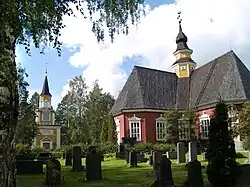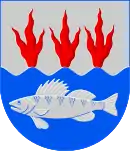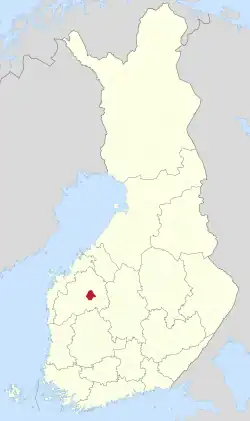Kuortane | |
|---|---|
Municipality | |
| Kuortaneen kunta Kuortane kommun | |
 Old church of Kuortane in 2012 | |
 Coat of arms | |
 Location of Kuortane in Finland | |
| Coordinates: 62°48.5′N 023°30.5′E / 62.8083°N 23.5083°E | |
| Country | |
| Region | South Ostrobothnia |
| Sub-region | Kuusiokunnat sub-region |
| Government | |
| • Municipal manager | Teemu Puolijoki |
| Area (2018-01-01)[1] | |
| • Total | 484.88 km2 (187.21 sq mi) |
| • Land | 462.37 km2 (178.52 sq mi) |
| • Water | 22.72 km2 (8.77 sq mi) |
| • Rank | 189th largest in Finland |
| Population (2023-09-30)[2] | |
| • Total | 3,384 |
| • Rank | 206th largest in Finland |
| • Density | 7.32/km2 (19.0/sq mi) |
| Population by native language | |
| • Finnish | 98.1% (official) |
| • Swedish | 0.1% |
| • Others | 1.8% |
| Population by age | |
| • 0 to 14 | 13.9% |
| • 15 to 64 | 53.1% |
| • 65 or older | 33.1% |
| Time zone | UTC+02:00 (EET) |
| • Summer (DST) | UTC+03:00 (EEST) |
| Website | www.kuortane.fi |
Kuortane is a municipality of Finland. It is located in the South Ostrobothnia region. The municipality has a population of 3,384 (30 September 2023)[2] and covers an area of 484.88 square kilometres (187.21 sq mi) of which 22.72 km2 (8.77 sq mi) is water.[1] The population density is 7.32 inhabitants per square kilometre (19.0/sq mi). The neighboring municipalities of Kuortane are Alajärvi, Alavus, Lapua and Seinäjoki. The municipality is unilingually Finnish.
Kuortane has a notable history of pine tar production. It is currently well known for the Kuortaneen urheilulukio, a sports institute (Olympic Training centre) and training facility where many young Finnish athletes study and train. Both the women's national under-18 ice hockey team and Team Kuortane of the Naisten Liiga are based at the institute. Kuortane is also known as the birthplace of world-famous architect Alvar Aalto.
Notable people
- Alvar Aalto (1898–1976), architect and designer
- Osmo Ala-Honkola (1939–2020), Olympic sport shooter
- Reino Ala-Kulju (1898–1983), Lutheran clergyman, politician, and teacher
- Mira Suhonen (born 1985), Olympic sport shooter
See also
References
- 1 2 "Area of Finnish Municipalities 1.1.2018" (PDF). National Land Survey of Finland. Retrieved 30 January 2018.
- 1 2 "Preliminary population statistics 2023, September". StatFin. Statistics Finland. Retrieved 26 October 2023.
- ↑ "Demographic Structure by area as of 31 December 2022". Statistics Finland's PX-Web databases. Statistics Finland. Retrieved 6 September 2023.
- ↑ "Population according to age (1-year) and sex by area and the regional division of each statistical reference year, 2003–2020". StatFin. Statistics Finland. Retrieved 2 May 2021.
External links
 Media related to Kuortane at Wikimedia Commons
Media related to Kuortane at Wikimedia Commons- Municipality of Kuortane – Official website (in Finnish)
- Kuortane Olympic Training Center – Official website (in Finnish and English)
